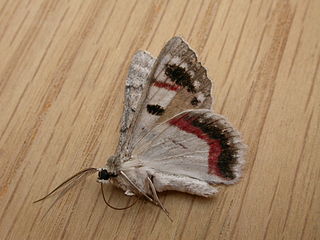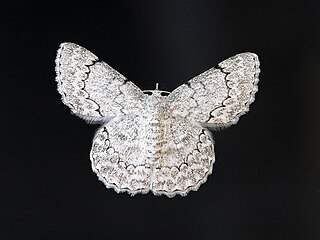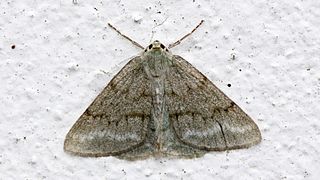
The grass emerald is a species of moth. It occurs throughout central and south-eastern Europe and in Asia Minor and the Caucasus further east to the Urals and Siberia. It is fairly common throughout Great Britain with the exception of northern Scotland. In the southern Alps, it rises up to 1500 metres. The species was first described by Johann Siegfried Hufnagel in 1767.

Geometrinae is the nominate subfamily of the geometer moth family (Geometridae). It is strongly split, containing a considerable number of tribes of which most are presently very small or monotypic. These small moths are often a light bluish green, leading to the common name of emerald moths, though a few species called thus are also found in the tribe Campaeini of the Ennominae. In 2018, a phylogeny and classification based on a molecular phylogenetic analysis was published in the Zoological Journal of the Linnean Society in which 13 tribes were accepted.

Though small in absolute diversity of genera, the Hemitheini are nonetheless the largest tribes of geometer moths in the subfamily Geometrinae. Like most Geometrinae, they are small greenish "emerald moths". The tribe was first described by Charles Théophile Bruand d'Uzelle in 1846.

Scopula immorata, the Lewes wave, is a moth of the family Geometridae. It is found throughout Europe and the Near East.

Crypsiphona ocultaria the red-lined looper moth or red-lined geometer, is a moth of the family Geometridae. The species was first described by Edward Donovan in 1805 and it is found in Australia.

Aeolochroma is a genus of moths in the family Geometridae described by Prout in 1912.

Dindica is a genus of moths in the family Geometridae.
Godonela was a genus of moths in the family Geometridae. It is now considered a synonym of Semiothisa, though many of the species formerly placed here are now in Chiasmia

Hypodoxa is a genus of moths in the family Geometridae described by Prout in 1912.

Pingasa is a genus of moths in the family Geometridae first described by Frederic Moore in 1887.

Pseudoterpna is a genus of moths in the family Geometridae first described by Jacob Hübner in 1823.

Timandra is a genus of moths in the family Geometridae first described by Philogène Auguste Joseph Duponchel in 1829.

Sterrhinae is a large subfamily of geometer moths with some 3,000 described species, with more than half belonging to the taxonomically difficult, very diverse genera, Idaea and Scopula. This subfamily was described by Edward Meyrick in 1892. They are the most diverse in the tropics with the number of species decreasing with increasing latitude and elevation.

Pingasa chlora, the white looper moth or flower-eating caterpillar, is a species of moth of the family Geometridae first described by Caspar Stoll in 1782. It is found Sundaland, the Philippines, Sulawesi and from the Moluccas to Queensland, Australia.
Louis Beethoven Prout (1864–1943) was an English entomologist and musicologist.

Pseudoterpna coronillaria, the Jersey emerald or gorse emerald, is a moth of the family Geometridae. The species was first described by Jacob Hübner in 1796. It is known from Spain, Portugal, the Pyrenees, western and southern France, Corsica, Sardinia, Sicily, Italy, Samos, Rhodes, Turkey, Israel, Lebanon, northern Jordan and North Africa. It has not been reported from mainland Great Britain, but is present on Jersey, where it was previously overlooked as a form of the grass emerald, until 2001 when it was correctly identified.

The Pseudoterpnini are a tribe of geometer moths in the subfamily Geometrinae. The tribe was described by Warren in 1893. It was alternatively treated as subtribe Pseudoterpniti by Jeremy Daniel Holloway in 1996.

Pseudoterpna corsicaria is a moth of the family Geometridae first described by Jules Pierre Rambur in 1833. It is found on Corsica and Sardinia.
Pseudoterpna simplex is a moth of the family Geometridae first described by Sergei Alphéraky in 1892. It is found in central Asia, including Xinjiang in China.
Pseudoterpna lesuraria is a moth of the family Geometridae first described by Daniel Lucas in 1933. It is found in Morocco.













